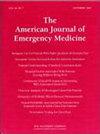用体外循环方法成功治疗了严重的咖啡因中毒:病例报告。
IF 2.7
3区 医学
Q1 EMERGENCY MEDICINE
引用次数: 0
摘要
一名 20 岁女性在 80 分钟前摄入 18 克咖啡因和 3500 毫克美西律汀,随后被救护车送往医院。到达急诊室时,她的生命体征如下:血压 65/37 mmHg;心率 140 次/分;格拉斯哥昏迷量表 E4V4M6。实验室分析显示存在低钾血症和乳酸酸中毒。患者在气管内插管、静脉注射去甲肾上腺素、洗胃和服用活性炭后接受了机械通气治疗。不久后,她出现了无脉性室性心动过速,于是开始静脉-动脉体外膜肺氧合(VA-ECMO)。随着循环衰竭的持续,在持续静脉输注去甲肾上腺素的同时进行了血液透析(HD)。血液透析结束后,减少了去甲肾上腺素的剂量。住院第 2 天,又进行了血液透析。住院第 3 天和第 4 天,患者脱离了 VA-ECMO 和呼吸机。入院时,咖啡因和美西律汀的血药浓度分别为 387 μg/mL 和 1.1 μg/mL。在第一次 HD 期间,这两种药物的血药浓度明显降低。有报道称,美西列汀可能通过抑制 N-去甲基化而降低咖啡因的清除率。在这种情况下,根据血药浓度计算出的咖啡因内源性清除率大大低于估计值。如果没有进行血液透析,可能需要更长的时间才能脱离 VA-ECMO,因为在美西律存在的情况下咖啡因的清除率会降低。值得注意的是,在使用甲氰咪胍时,咖啡因中毒会更加严重,持续时间也更长。本文章由计算机程序翻译,如有差异,请以英文原文为准。
Severe caffeine poisoning with mexiletine successfully treated by extracorporeal methods
A 20-year-old woman was brought to the hospital in an ambulance after ingesting 18 g of caffeine and 3500 mg of mexiletine 80 min earlier. On arrival at the emergency department, her vital signs were as follows: blood pressure, 65/37 mmHg; heart rate, 140 beats/min; and Glasgow Coma Scale, E4V4M6. Laboratory analyses revealed hypokalemia and lactic acidosis. The patient was treated with mechanical ventilation after intratracheal intubation, intravenous noradrenaline infusion, gastric lavage, and activated charcoal administration. Shortly afterwards, she developed pulseless ventricular tachycardia, and veno-arterial extracorporeal membrane oxygenation (VA-ECMO) was initiated. As the circulatory collapse continued, hemodialysis (HD) was performed with continuous intravenous infusion of noradrenaline. After the completion of HD, the noradrenaline dose was reduced. On hospital day 2, HD was performed on the second day of hospitalization. On hospital days 3 and 4, the patient was weaned off VA-ECMO and ventilator. The blood concentrations of caffeine and mexiletine at presentation were 387 μg/mL and 1.1 μg/mL respectively. During the first HD, blood concentrations of both drugs were markedly reduced.
It has been reported that mexiletine may reduce the clearance of caffeine probably via inhibition of N-demethylation. In this case, the endogenous clearance of caffeine, calculated from blood concentrations, was considerably lower than estimated. If HD had not been performed, it may have taken longer to wean off the VA-ECMO because of reduced caffeine clearance in the presence of mexiletine. Notably, caffeine poisoning is more severe and prolonged when mexiletine is administered.
求助全文
通过发布文献求助,成功后即可免费获取论文全文。
去求助
来源期刊
CiteScore
6.00
自引率
5.60%
发文量
730
审稿时长
42 days
期刊介绍:
A distinctive blend of practicality and scholarliness makes the American Journal of Emergency Medicine a key source for information on emergency medical care. Covering all activities concerned with emergency medicine, it is the journal to turn to for information to help increase the ability to understand, recognize and treat emergency conditions. Issues contain clinical articles, case reports, review articles, editorials, international notes, book reviews and more.

 求助内容:
求助内容: 应助结果提醒方式:
应助结果提醒方式:


